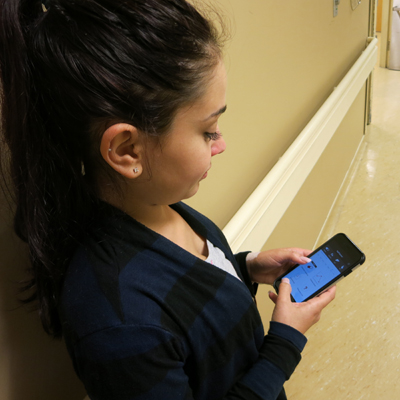
Patty Gallo, 28, shares her story about living with beta thalassemia – a diagnosis she has kept secret until now. (Photo: Patty Gallo)
When Patty Gallo was six months old, her mother noticed something odd – Patty's fingers were turning an unnatural shade of purple and blue.
Her mother immediately took her to the family doctor to see what was wrong. Patty was referred to The Hospital for Sick Children, where she received a life-changing diagnosis – one she's kept secret until now.
Patty is a patient at Toronto General Hospital living with beta thalassemia.
Thalassemia, a genetic blood disease, prevents those affected from producing normal hemoglobin to produce healthy red blood cells. These cells play an important role in carrying fresh oxygen throughout the body. Low levels of hemoglobin can cause tiredness, irregular heartbeats, pale skin, and in severe cases, heart failure.
According to the World Health Organization, approximately five per cent of the world's population carries trait genes for hemoglobin disorders, mainly,
sickle-cell disease and thalassemia.
While you would never know from her physical appearance, 28-year-old Patty has been receiving blood transfusions once per month since she was six months old. These transfusions keep her alive – but they come at a cost – excess iron with each transfusion.

Since March 2015, Patty has been using thalTracker, a new UHN app helping thalassemia patients self-manage their chronic disease. (Photo: UHN)
Introducing thalTracker: New self-management app for thalassemia patients
Since March 2015, Patty has been using a new app – thalTracker – developed by Dr. Richard Ward, Hematologist and Director, Red Blood Cell Disorders Program, and Karim Taha, a fourth-year medical student at the University of Toronto. It helps patients like Patty track levels of iron overload, improve adherence to medication and take control of their chronic blood disease.
Designed with input and feedback from patients in Toronto and the United States,
thalTracker is available for free download in the Apple App Store and has been downloaded by patients around the world, including Europe and Australia.
"We are dealing with a young population of patients, usually 18-40, that require blood transfusions every month to survive," says Dr. Ward. "This causes a build-up of iron in the liver, spleen, pancreas, brain and eventually, in the heart.
"While we offer medications to remove iron from the body, many patients often go into organ failure."
Patty recalls such a time in her life – when doctors told her she was a "ticking time bomb."
Keeping Patty alive
In 2012, Patty was going into heart failure, with an extreme iron overload in her liver and heart. For six months, a PIC line was inserted – a long, thin, hollow tube placed into a vein above the bend of her elbow – to pump high dosage medication into her body to reduce iron levels and keep her alive.
"I remember wearing really baggy sweaters and carrying around a pump the size of a baby bottle," Patty says. "I had to wear it every day for six months – and I hid it from everyone.
"That's the thing about living with a chronic condition your whole life – I never wanted to be treated differently."

Patty, who uses thalTracker up to three times per day, says “it holds me accountable for managing my own health.” (Photo: Patty Gallo)
But today, Patty is speaking out about her complex diagnosis – and she's determined not to let this disease control her.
"The app forces me to smarten up and pay attention," she says. "I use thalTracker up to three times per day. It allows me to track important results that help me, my doctors and nurses understand how I'm doing.
"My medications can be really hard on my body – so while I don't want to take them, having an app in place with notifications holds me accountable for managing my own health."
With a survey built into the app, Dr. Ward and Karim hope to gather important feedback from patients about thalTracker in an effort to improve the effectiveness of the app.
"I've always been interested in the relationship between technology and medicine," says Karim. "The next step will be to publish our experience and share our evidence-based approach to building this self-management tool."
*From June 1-July 31, the Canadian Blood Services hosts the annual inter-hospital challenge to encourage hospitals across South Central Ontario to donate blood and help patients like Patty with complex blood disorders receive blood transfusions they need to live. Find out more about how you can donate blood,
here.
